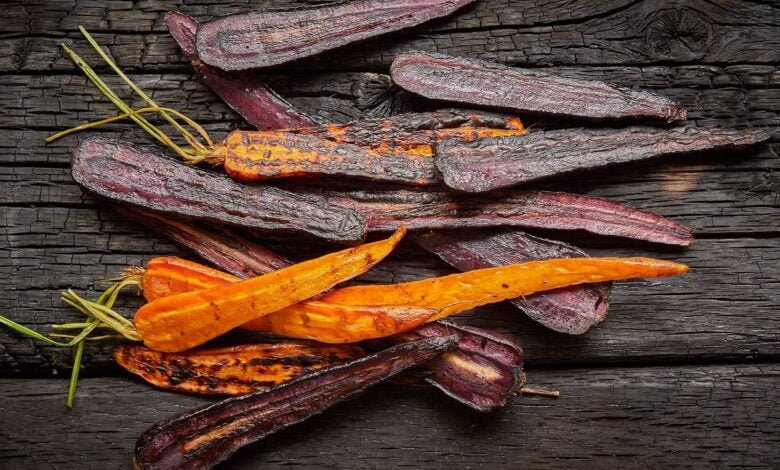Charring makes food taste amazing. But is it safe?

I love crisped, charred foods. From crispy, cheesy topped dips to uber-crisp chicken cutlets to pasta dishes that have been browned in the broiler, I crave a darkened, bronzed texture in practically anything that I make or eat — and I know I’m not alone.
Texture is a massive component in food, sometimes perhaps even more so than flavor, and it’s something that I am always striving for in my own cooking. In most instances, that means veering into the world of char, or even sometimes downright overcooking, but how safe is that cooking technique? Or, put another way: Just how unhealthy is ingesting burned or charred food?
Before diving into the safety of char, it’s important to understand its appeal to cooks. Chef Tyler Fenton helms the nationally acclaimed restaurant BATA in Tucson, Ariz, which is celebrated for its hearth and bright, inventive dishes — along with lots and lots of charring. When I asked Fenton what he likes to char and what is often a starring ingredient on his menu, he replied, “Everything!”
“But especially vegetables,” Fenton said. “Just take your steamed broccoli compared to hard-charred broccoli — the char brings out a new level of flavor and makes it really special. Meat-wise, think of a boiled steak compared to a hard-charred steak. It’s a no brainer. Char makes everything taste better.”
BATA’s hearth was custom-designed by one of Fenton’s good friends and has zones with different types of grilling surfaces, modular shelves for prepping and custom-designed areas for different cooking purposes, like heat with no smoke, or an area for smoke with limited heat.
“It’s very specific to what we do on a daily basis. Our hearth is under a hood to keep airflow constantly moving. When the smoke is drawn up and through, as opposed to an offset smoker that has a heavy smoke penetration, you get a really clean smoke flavor on things. We like to say it ‘nicely perfumes everything,” Fenton said.
When I asked Fenton about that fine line between charring and boring, which can cross the threshold from crispy and browned to acrid and unappealing, he said that “it’s about the penetration of the char.”
“A really hard char is surface level, whereas burning is when you have that charred texture throughout,” he said. “If you think about a piece of toast, you can have a deep caramelization on the outside of the toast that may look burnt, but the middle is still fluffy, happy bread. As soon as you have a piece of toast that is charred all the way through, that’s when you cross into burnt land.”
Fenton’s unique approach also touches on incorporating charred flavor notes in different manners. “Lately we’ve been taking the trim of onions and holding it over the fire to dry it out completely. We then turn that into a powder that we use to lightly dust dishes with. Think [of] a raw fish dish with a wisp of smoked onion powder. Or sometimes that powder gets incorporated into sausage as a seasoning. We often take ingredients a step further.”
He also spoke about utilizing ash in his dishes, which adds a slightly different flavor profile than outright grilling or smoking.
Of course, Fenton’s usage of BATA’s special hearth certainly differs from the grill you might have in the backyard, but at the end of the day, we’re all using grills for the same reason, right? A hot dog cooked in any way is no comparison for a grilled hot dog. Same for burgers. This is evident. And we’ve all been eating grilled burgers and hot dogs, whether made with animal products or not, for a long, long time.
Yet, Nichole Dandrea-Russert — a dietician and the author of “The Vegan Athlete’s Nutrition Handbook — charred red meat, or meat in general, is actually more potentially harmful than charring practically anything else.
“Chemicals called heterocyclic amines (HCAs) and polycyclic aromatic hydrocarbons (PAHs) are formed when meat is cooked using high temperatures, like pan frying or grilling, or when meat is cooked over an open flame,” Dandrea-Russert said. “Heterocyclic amines are formed through protein, sugar, and creatine in meat reacting at high temperatures. Polycyclic aromatic hydrocarbons form when fat and juices from meat drip over an open flame, causing smoke that contains PAHs to adhere to the surface of the meat. The higher the temperature and the longer the meat is cooked, the higher the potential for these compounds to form. When consumed, these chemicals can cause changes in DNA that may increase the risk of cancer.”
“When consumed, these chemicals can cause changes in DNA that may increase the risk of cancer.”
Dandrea-Russert advises “avoiding direct exposure of meat to an open flame, avoiding prolonged cooking times (especially at high temperatures), and removing charred areas of meat before consuming.”
“Red meat is already linked to cancer, heart disease and diabetes and is classified as a type 2A carcinogen by the World Health Organization,” she continued. “This means that it is probably carcinogenic to humans as demonstrated by epidemiological studies. Smoked and processed meats are considered a type 1 carcinogen, meaning that there is sufficient evidence demonstrating that they are carcinogenic to humans.”
She notes that plant-based foods, conversely, are “shown to reduce the risk of cancer, heart disease and diabetes.” Now, charring plant-based foods sort of complicates this, of course, but it’s more advisable, generally, to char some zucchini than it is to char a porterhouse steak, essentially.
At the same time, Dandrea-Russert also notes that certain plant-based foods, such as potatoes or bread, can also produce a chemical called acrylamides when cooked over especially high heat. She notes “acrylamides have also been associated with increased risk of certain types of cancer. Aim for golden yellow colors, instead of brown or charred, when toasting bread or roasting starchy foods, like potatoes.”
Let’s be honest, though: Flaccid, yellow fries or roasted ‘taters are certainly not as delicious as crisp, deeply browned ones, a true catch-22. That’s where moderation comes into play, per Dandrea-Russert.
“The total amount and length of time can make a difference. Minimizing the amount of HCAs and PAHs, as well as frequency of exposure, is recommended if you want to minimize risk of cancer from these chemicals,” she said.
Read more
about this topic
Source link




